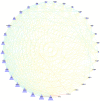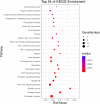Based on network pharmacology and molecular docking to predict the mechanism of Huangqi in the treatment of castration-resistant prostate cancer
- PMID: 35594510
- PMCID: PMC9122509
- DOI: 10.1371/journal.pone.0263291
Based on network pharmacology and molecular docking to predict the mechanism of Huangqi in the treatment of castration-resistant prostate cancer
Abstract
Background: As a kind of traditional Chinese medicine, HQ is widely mentioned in the treatment of cancerous diseases in China, which has been proven to have a therapeutic effect on cancerous diseases, such as prostate cancer. To predict the specific mechanism of HQ in the treatment of CRPC, we will conduct preliminary verification and discussion based on a comprehensive consideration of network pharmacology and molecular docking.
Methods: TCMSP was used to obtain the compounds and reach the effective targets of HQ. The targets of CRPC were reached based on GeneCards database and CTD database. GO and KEGG were utilized for the analysis of overlapping targets. The software of Openbabel was used to convert the formats of ligands and reporters. In addition, molecular docking studies were performed by using the software of Autodock Vina.
Result: It can be seen from the database results that there were 87 active compounds (20 key active compounds) in HQ, and 33 targets were screened out for CRPC treatment. GO and KEGG pathway enrichment analyses identified 81 significant GO terms and 24 significant KEGG pathways. There is a difference in terms of the expression of core protein between cancer patients and healthy people. The expression of core protein in patients also has an impact on the life cycle. The results of molecular docking showed that the docking activity of drug molecules and core proteins was better.
Conclusions: It is concluded from the results of this network pharmacology and molecular docking that HQ makes a multi-target and multi-biological process, and results in the multi-channel synergistic effect on the treatment of CRPC by regulating cell apoptosis, proliferation and metastasis, which still needs further verification by experimental research.
Conflict of interest statement
The authors have declared that no competing interests exist.
Figures










Similar articles
-
Potential mechanisms of Pyrrosiae Folium in treating prostate cancer based on network pharmacology and molecular docking.Drug Dev Ind Pharm. 2022 May;48(5):189-197. doi: 10.1080/03639045.2022.2088785. Epub 2022 Aug 5. Drug Dev Ind Pharm. 2022. PMID: 35730236
-
Research on the Mechanism of Guizhi to Treat Nephrotic Syndrome Based on Network Pharmacology and Molecular Docking Technology.Biomed Res Int. 2021 Nov 27;2021:8141075. doi: 10.1155/2021/8141075. eCollection 2021. Biomed Res Int. 2021. PMID: 34873575 Free PMC article.
-
Integration of network pharmacology and molecular docking technology reveals the mechanism of the herbal pairing of Codonopsis Pilosula (Franch.) Nannf and Astragalus Membranaceus (Fisch.) Bge on chronic heart failure.Ann Palliat Med. 2021 Jul;10(7):7942-7959. doi: 10.21037/apm-21-1469. Ann Palliat Med. 2021. PMID: 34353081
-
Exploration of the mechanism of Zisheng Shenqi decoction against gout arthritis using network pharmacology.Comput Biol Chem. 2021 Feb;90:107358. doi: 10.1016/j.compbiolchem.2020.107358. Epub 2020 Aug 8. Comput Biol Chem. 2021. PMID: 33243703 Review.
-
Application of network pharmacology in synergistic action of Chinese herbal compounds.Theory Biosci. 2024 Sep;143(3):195-203. doi: 10.1007/s12064-024-00419-2. Epub 2024 Jun 18. Theory Biosci. 2024. PMID: 38888845 Review.
Cited by
-
Novel systems biology experimental pipeline reveals matairesinol's antimetastatic potential in prostate cancer: an integrated approach of network pharmacology, bioinformatics, and experimental validation.Brief Bioinform. 2024 Jul 25;25(5):bbae466. doi: 10.1093/bib/bbae466. Brief Bioinform. 2024. PMID: 39297880 Free PMC article.
-
Exploring the mechanism of 6-Methoxydihydrosanguinarine in the treatment of lung adenocarcinoma based on network pharmacology, molecular docking and experimental investigation.BMC Complement Med Ther. 2024 May 23;24(1):202. doi: 10.1186/s12906-024-04497-z. BMC Complement Med Ther. 2024. PMID: 38783288 Free PMC article.
-
Salsolinol improves angiotensin II‑induced myocardial fibrosis in vitro via inhibition of LSD1 through regulation of the STAT3/Notch‑1 signaling pathway.Exp Ther Med. 2023 Sep 27;26(5):527. doi: 10.3892/etm.2023.12226. eCollection 2023 Nov. Exp Ther Med. 2023. PMID: 37869646 Free PMC article.
-
Targeting beta-lactamase activity with Oxacyclohexadecan-2-one in carbapenem-resistant uropathogenic E. coli: A molecular simulation approach.PLoS One. 2025 Feb 18;20(2):e0317941. doi: 10.1371/journal.pone.0317941. eCollection 2025. PLoS One. 2025. PMID: 39964973 Free PMC article.
-
Exploring the mechanism of ellagic acid against gastric cancer based on bioinformatics analysis and network pharmacology.J Cell Mol Med. 2023 Dec;27(23):3878-3896. doi: 10.1111/jcmm.17967. Epub 2023 Oct 4. J Cell Mol Med. 2023. PMID: 37794689 Free PMC article.
References
-
- Bray Freddie, Ferlay Jacques, Soerjomataram Isabelle, Siegel Rebecca L, Torre Lindsey A, Jemal Ahmedin. Global cancer statistics 2018:GLOBOCAN estimates of incidence and mortality worldwide for 36 cancers in 185 countries[J]. CA Cancer J Clin. 2018. Nov;68(6):394–424. doi: 10.3322/caac.21492 - DOI - PubMed
-
- Global Burden of Disease Cancer Collaboration, Fitzmaurice C, Akinyemiju TF, et al.. Global, regional, and national cancer incidence, mortality, years of life lost, years lived with disability, and disability-adjusted life-years for 29 cancer groups, 1990 to 2016: A systematic analysis for the Global Burden of Disease Study. JAMA Oncol, 2018, 4 (11): 1553–1568. doi: 10.1001/jamaoncol.2018.2706 - DOI - PMC - PubMed
Publication types
MeSH terms
Substances
Associated data
LinkOut - more resources
Full Text Sources
Research Materials

